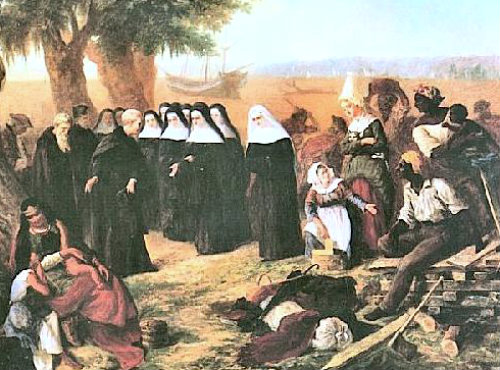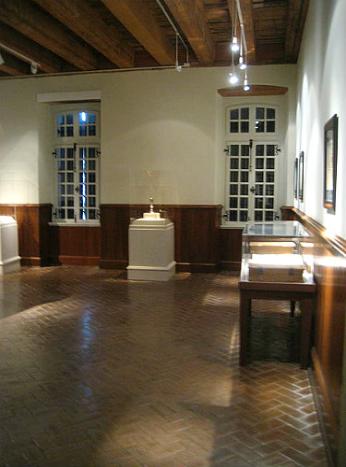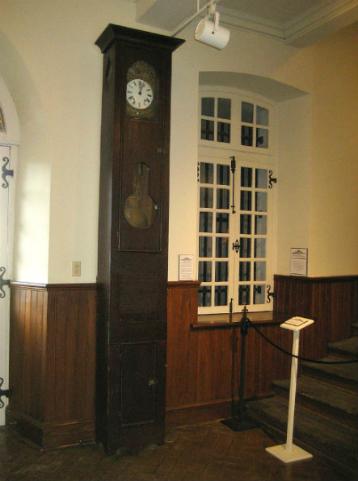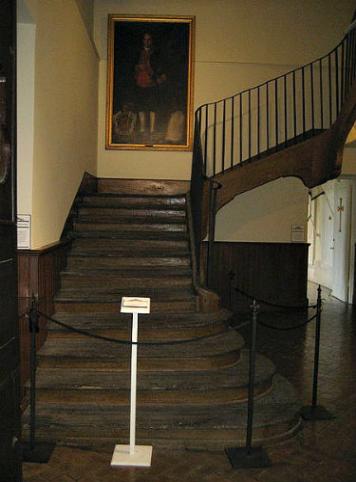
| It would be hard to say who was more relieved when the Ursuline nuns first arrived in New Orleans in 1727: the colonists, who were in sore need of their aid, or the sisters, who'd endured a harrowing 5-month journey from their native France. |
| The Landing of the Ursulines |
| The second building constructed for the Ursulines, completed in 1751, now houses the archive for the Archdiocese of New Orleans. The museum is open to the public. Many of the interior furnishings, including the clock and staircase pictured above, pre-date this building and go back to at least 1734. |
| Even for the time, the nuns' trip was longer and fraught with more peril than the usual ocean journey. When they arrived at New Orleans, the citizens were astonished to see them, by then, being certain they'd perished at sea. |
| William Cole gives a dramatic account of their journey in "Historical Sketchbook and Guide to New Orleans," published in 1885: |
| "As a result of this [requesting help from the Ursulines of Rouen], Tranchepain, an Ursuline nun, left France with nine professed companions, one novice and two servants, in the ship Gironde, February 22, 1727. |
| "The Gironde was provisioned as for a siege, but the accommodations for passengers were wretched. During the voyage, they encountered terrific storms, were pursued by corsairs, and at one time, all the ladies had to assume male attire and man the ship to save her from pirates. |
| "The ship, after meeting fearful winds in the Caribbean Sea, being stranded on Dauphin Island and losing nearly all her cargo, reached Louisiana in July. At Balize [at the mouth of the Mississippi River, now known at Pilottown], the travelers were transferred to pirogues, their trunks stored in the center. |
| "After several days of river journeying, they reached the scene of their future labors, the village of New Orleans." |
| The image at the top of the page, depicting the arrival of the Ursulines, is of great importance, it's the only glimpse of New Orleans taken in that early period. Madeleine Hauchard first made a sketch of the event and later enlarged it. (Madeleine is the young lady in the tall white novice's cap, holding the cat she brought with her from France.) |
| From the "Times-Picayune Guide to New Orleans," published in 1904: |
| "The Landing of the Ursuline Nuns is the most historic picture in Louisiana. It is taken from a sketch made by Madeleine Hauchard. As they were being met by officials and clergy, Madeleine paused and rapidly sketched the scene. |
| "The sketch, faithfully preserved by the Ursulines, was subsequently enlarged by Madeleine and hangs in the Convent parlors within the strict enclosure. Upon completing the picture, she placed herself among the Sisterhood, she is recoginzed by the cap she wears and the pet cat she brought all the way from her old home. |
| "For 40 years, Madeleine devoted herself to religion, education and charity. For 38 years, she faithfully kept a diary, the daily events of all that happened in the colony. This diary, preserved in the old Convent, is the only record extant of those early days. |
| "It is recorded in the order that Madeleine was the life and heart of the community from the time that it set sail on the unknown seas in 1727 until the time of her death. One may imagine what a tower of strength such a sweet, sturdy, optimistic character must have been to that brave band of pioneer women in Louisiana." |




| The building served as convent, girls' school, orphanage and sometimes infirmary when the Ursulines were there. Above, an old school desk; below, once the orphans' dining room. |
| The convent is the only surviving example of French colonial public architecture in the United States and the oldest building in the Mississippi Valley. |
| You might also enjoy: Sister Xavier's Herb Garden at the Old Convent |
| It is on the National Register of Historic Places and the list of National Historic Landmarks. New Orleans' Ursuline Academy is the oldest continually operating Catholic school in the U.S. |
| The current photos of the Convent are courtesy of Infrogmation @ WikimediaCommons. |
| Back to Old New Orleans Whispers - Home |